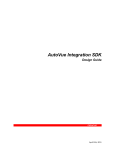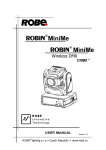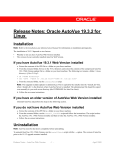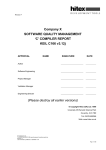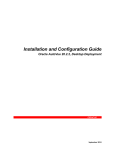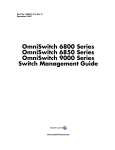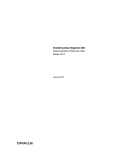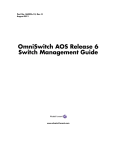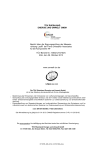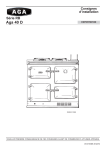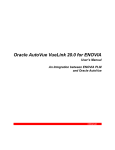Download Oracle AutoVue Testing Guide
Transcript
Oracle® AutoVue Testing Guide Release 20.2.2 September 2013 Oracle AutoVue Testing Guide, Release 20.2.2 Copyright © 1999, 2013, Oracle and/or its affiliates. All rights reserved. This software and related documentation are provided under a license agreement containing restrictions on use and disclosure and are protected by intellectual property laws. Except as expressly permitted in your license agreement or allowed by law, you may not use, copy, reproduce, translate, broadcast, modify, license, transmit, distribute, exhibit, perform, publish, or display any part, in any form, or by any means. Reverse engineering, disassembly, or decompilation of this software, unless required by law for interoperability, is prohibited. The information contained herein is subject to change without notice and is not warranted to be error-free. If you find any errors, please report them to us in writing. If this is software or related documentation that is delivered to the U.S. Government or anyone licensing it on behalf of the U.S. Government, the following notice is applicable: U.S. GOVERNMENT RIGHTS Programs, software, databases, and related documentation and technical data delivered to U.S. Government customers are "commercial computer software" or "commercial technical data" pursuant to the applicable Federal Acquisition Regulation and agency-specific supplemental regulations. As such, the use, duplication, disclosure, modification, and adaptation shall be subject to the restrictions and license terms set forth in the applicable Government contract, and, to the extent applicable by the terms of the Government contract, the additional rights set forth in FAR 52.227-19, Commercial Computer Software License (December 2007). Oracle America, Inc., 500 Oracle Parkway, Redwood City, CA 94065. This software or hardware is developed for general use in a variety of information management applications. It is not developed or intended for use in any inherently dangerous applications, including applications that may create a risk of personal injury. If you use this software or hardware in dangerous applications, then you shall be responsible to take all appropriate fail-safe, backup, redundancy, and other measures to ensure its safe use. Oracle Corporation and its affiliates disclaim any liability for any damages caused by use of this software or hardware in dangerous applications. Oracle and Java are registered trademarks of Oracle and/or its affiliates. Other names may be trademarks of their respective owners. This software or hardware and documentation may provide access to or information on content, products, and services from third parties. Oracle Corporation and its affiliates are not responsible for and expressly disclaim all warranties of any kind with respect to third-party content, products, and services. Oracle Corporation and its affiliates will not be responsible for any loss, costs, or damages incurred due to your access to or use of third-party content, products, or services. Portions of this software Copyright 1996-2007 Glyph & Cog, LLC. Portions of this software Copyright Unisearch Ltd, Australia. Portions of this software are owned by Siemens PLM © 1986-2012. All rights reserved. This software uses ACIS® software by Spatial Technology Inc. ACIS® Copyright © 1994-2008 Spatial Technology Inc. All rights reserved. Contents Preface ................................................................................................................................................................. v 1 Introduction 1.1 1.2 1.3 1.4 1.5 1.6 Systems Integration Testing ...................................................................................................... User Acceptance Testing............................................................................................................ Putting SIT and UAT in Context: Phases of a Deployment .................................................. Differences Between UAT and SIT ........................................................................................... Overview of this Document ...................................................................................................... Terminology................................................................................................................................. 1-1 1-1 1-1 1-3 1-3 1-4 2 SIT Process Requirements 2.1 2.1.1 2.1.2 2.1.3 2.2 2.3 How Many Rounds of SIT ......................................................................................................... Test Environment................................................................................................................. Staging Environment........................................................................................................... Production Environment .................................................................................................... Schedule ....................................................................................................................................... Test Plan ....................................................................................................................................... 2-1 2-1 2-1 2-1 2-1 2-2 3 UAT Process Requirements 3.1 3.2 3.3 3.4 How Many Rounds of UAT ...................................................................................................... Schedule ....................................................................................................................................... Scenarios....................................................................................................................................... User Training ............................................................................................................................... 3-1 3-1 3-1 3-2 4 AutoVue Testing Guidelines 4.1 4.2 4.3 4.3.1 4.3.2 4.3.3 4.4 4.4.1 4.4.2 Internal / External Users ........................................................................................................... Environment / Architecture...................................................................................................... Sample Designs ........................................................................................................................... Format Selection................................................................................................................... Realistic Designs .................................................................................................................. Format Fidelity..................................................................................................................... Integrated Tests ........................................................................................................................... Open Designs ....................................................................................................................... Comparing Versions............................................................................................................ 4-1 4-1 4-2 4-2 4-2 4-2 4-2 4-3 4-3 iii 4.4.3 4.4.4 4.4.5 4.5 4.5.1 4.5.2 4.5.3 4.5.4 4.6 4.7 4.7.1 4.7.2 4.7.3 4.7.4 4.8 4.9 4.9.1 4.9.2 4.9.3 Creation of Stamp Markup................................................................................................. Renditions ............................................................................................................................. Customizations .................................................................................................................... Markups ....................................................................................................................................... Creation and Saving of Markups ...................................................................................... Opening Saved Markups .................................................................................................... Markup Permissions ........................................................................................................... DMS Markup Storage.......................................................................................................... Performance ................................................................................................................................. General Functionality ................................................................................................................. Printing.................................................................................................................................. Measurements ...................................................................................................................... Design Conversion .............................................................................................................. Customized GUI .................................................................................................................. Real-Time Collaboration Functionality ................................................................................... Format Specific Functionality ................................................................................................... 2D-Specific Functionality.................................................................................................... 3D-Specific Functionality.................................................................................................... EDA-Specific Functionality ................................................................................................ 4-3 4-3 4-3 4-3 4-3 4-4 4-4 4-4 4-4 4-4 4-5 4-5 4-5 4-5 4-5 4-6 4-6 4-6 4-6 5 SIT-Specific Guidelines 5.1 5.1.1 5.1.2 5.1.3 5.2 5.3 Upgrades ...................................................................................................................................... Open and Resave Old Markups ........................................................................................ Cached Files.......................................................................................................................... Configuration ....................................................................................................................... Streaming Files ............................................................................................................................ Patches .......................................................................................................................................... 5-1 5-1 5-1 5-1 5-2 5-2 6 Sample SIT Test Plan 7 Sample UAT Scenarios 7.1 7.1.1 AVScenario1 - Internal User Review........................................................................................ 7-1 AVScenario2 - External User Post Review Feedback ..................................................... 7-2 8 Feedback 8.1 8.2 8.3 8.4 8.5 iv General AutoVue Information .................................................................................................. Oracle Customer Support .......................................................................................................... My Oracle Support AutoVue Community.............................................................................. AutoVue Integrations Forum .................................................................................................... Sales Inquiries.............................................................................................................................. 8-1 8-1 8-1 8-1 8-1 Preface The Testing Guide provides guidelines that should be followed when planning and performing Systems Integration Tests (SIT) and User Acceptance Tests (UAT) for an AutoVue deployment. For the most up-to-date version of this document, go to the AutoVue Documentation Web site on the Oracle Technology Network (OTN) at http://www.oracle.com/technetwork/documentation/autovue-091442.html Audience This document is intended for Oracle customers and partners who are deploying AutoVue in an enterprise environment. This guide serves as a good starting point for building your SIT and UAT scenarios to cover AutoVue functionality. Documentation Accessibility For information about Oracle's commitment to accessibility, visit the Oracle Accessibility Program website at http://www.oracle.com/pls/topic/lookup?ctx=acc&id=docacc. Access to Oracle Support Oracle customers have access to electronic support through My Oracle Support. For information, visit http://www.oracle.com/pls/topic/lookup?ctx=acc&id=info or visit http://www.oracle.com/pls/topic/lookup?ctx=acc&id=trs if you are hearing impaired. Related Documents For more information about Oracle AutoVue, refer to the following documents: ■ Oracle AutoVue, Client/Server Deployment Planning Guide ■ Oracle AutoVue, Client/Server Deployment Installation and Configuration Guide ■ Oracle AutoVue, Client/Server Deployment Security Guide ■ Oracle AutoVue, Client/Server Deployment Viewing Configuration Guide ■ Oracle AutoVue, Client/Server Deployment User's Manual ■ Oracle AutoVue, Client/Server Deployment Release Notes For more information about Oracle VueLinks, refer to the following documents: ■ Oracle VueLink for Documentum System Administrator Manual v ■ Oracle VueLink for Documentum User's Manual ■ Oracle VueLink for Oracle UCM System Administrator Manual ■ Oracle VueLink for Oracle UCM User's Manual ■ AutoVue VueLink for ENOVIA System Administrator Manual ■ AutoVue VueLink for ENOVIA User's Manual Conventions The following text conventions are used in this document: vi Convention Meaning boldface Boldface type indicates graphical user interface elements associated with an action, or terms defined in text or the glossary. italic Italic type indicates book titles, emphasis, or placeholder variables for which you supply particular values. monospace Monospace type indicates commands within a paragraph, URLs, code in examples, text that appears on the screen, or text that you enter. 1 Introduction 1 This document covers what you need to know when performing Systems Integration Testing and User Acceptance Testing. This section will explain both of these deployment phases, followed by an overview of the remainder of the document. 1.1 Systems Integration Testing Systems Integration Testing (SIT) is performed by the systems integrator once AutoVue has been installed and configured. The goal of SIT is to verify that all the technical aspects of a software solution have been installed and configured properly and are working as expected. SIT will typically happen several times in a typical deployment, as there are multiple environments which need to be installed, configured, and tested. 1.2 User Acceptance Testing User Acceptance Testing (UAT) is performed by a select group of users on the staging environment, once SIT has been completed. The users are selected in such a way that they cover all the business needs to be addressed by the AutoVue solution. UAT allows the users to try AutoVue in a realistic environment, and is required for users to sign off that the solution meets their business needs. 1.3 Putting SIT and UAT in Context: Phases of a Deployment In a typical AutoVue deployment there are five phases. Phase 1: Solution Requirements In the Solution Requirements phase, the business needs are identified. Phase 2: Solution Design & Architecture In the Solution Design & Architecture phase, a solution to the business problem is designed. All the necessary software components are identified, and the solution designer figures out how all these components will connect with each other. Hardware requirements such as the number of AutoVue servers and the number of application servers are identified. The entire architecture of the solution is documented in an architecture diagram showing all the hardware nodes, where each software component sits, and how the components communicate with each other. The solution is validated on paper to ensure all the software components are compatible with each other, with the operating systems, and with any other factors affecting the architecture (such as firewalls, geographic locations and load balancers). Phase 3: Test Environment Setup Introduction 1-1 Putting SIT and UAT in Context: Phases of a Deployment In the third phase a test environment is set up to test the solution. The test environment is recommended to be as close as possible as the final production environment, but there may be some differences such as fewer server nodes, due to cost. Machines are set up for each node in the test environment, and the appropriate software is installed and configured on each node. At this point Systems Integration Testing is done by the systems integrator to ensure that AutoVue works properly in this environment. Any technical issues should be worked out in Phase 3 before moving on. Figure 1–1 Phases of a Development Phase 4: Staging Environment Setup Phase 4 is similar to the test environment setup. Since this will be the final testing environment before going live, the staging environment is set up to be as close as possible to the final production environment. As in Phase 3, once the hardware and 1-2 Oracle AutoVue Testing Guide Overview of this Document software have been set up, Systems Integration Testing is done by the systems integrator to ensure all the technical components are functioning as they should. Finally User Acceptance Testing (UAT) is done by a set of users, who will try out the solution to ensure it meets their business needs. After the users sign off on the UAT, Phase 5 can begin. Phase 5: Production Environment Setup Setting up the production environment is the final stage of the deployment. All technical issues with the solution have been worked out, and the users have signed off on the solution meeting their business needs. The actual production hardware nodes are setup, and the software is installed and configured on each node. A final round of SIT is done to ensure no mistakes were made during installation and configuration. Once this round of SIT is done, the system goes live with users. 1.4 Differences Between UAT and SIT A common point of confusion is mixing up User Acceptance Testing (UAT) and Systems Integration Testing (SIT). Systems Integration Testing is to be performed by a systems integrator, and its goal is to validate that all technical aspects of the solution are working. By contrast, UAT is performed by a set of actual users of the system. The goal of UAT is to validate that the solution meets the users' needs and solves the original business problem as intended. Several, though not all, of the tests that will be performed will be common to both SIT and UAT; however, it is important to conduct both SIT and UAT. Systems integrators can't answer whether the solution meets business needs, and users should not be testing a system that has not first been validated by a systems integrator to work technically. Table 1–1 Differences Between UAT and SIT Systems Integration Testing User Acceptance Testing Deployment Phases Phase 4: Staging Env. Setup Phase 3: Test Env. Setup Phase 4: Staging Env. Setup Phase 5: Production Env. Setup Performed By Select group of users Systems Integrator Goal Ensure solution meets business needs Ensure technical aspects of solution works Preceded By SIT Software Installation and Configuration Followed By User Base Sign Off UAT Consists Of User Scenarios Individual Test 1.5 Overview of this Document This document explains what should be considered when planning SIT and UAT for AutoVue. It briefly covers how to fit SIT and UAT into your deployment process. Then it goes through some of the features of AutoVue, and what types of tests need to be performed to cover these features. The document also gives a short sample test plan to use as a starting point when developing your own test plans. Finally, some sample UAT test scenarios are presented to use as a guide when developing your own scenarios. Introduction 1-3 Terminology After reading this guide you should be able to create a series of systems integration tests to perform on your environment. Performing these tests on each environment will ensure that AutoVue, and all its components have been installed and configured properly, and work with any other components AutoVue has been integrated with. Similarly, after reading this guide you should be able to create a set of user acceptance testing scenarios for your environment. Having a select group of users run through these scenarios in a staging environment will allow them to sign off on the solution meeting their business needs. 1.6 Terminology Throughout this document the term DMS will be used to refer to all back-end systems that can be integrated with AutoVue such as Document Management System (DMS), Product Lifecycle Management (PLM), Enterprise Content Management (ECM), Enterprise Resource Planning (ERP), and so on. 1-4 Oracle AutoVue Testing Guide 2 SIT Process Requirements 2 This section covers some factors that should be taken into account when deciding how SIT should be organized and scheduled. 2.1 How Many Rounds of SIT For larger deployments, there will be three different environments that will need to be configured. Each environment will need to undergo SIT. 2.1.1 Test Environment It is recommended to plan at least two rounds of SIT for the test environment. This way, if configuration problems or product defects are found in the first round, there will be a second round to validate that any deployment changes have fixed the problem and have not introduced any new problems. 2.1.2 Staging Environment If the staging environment is identical in architecture to the test environment, then only one round of SIT may be necessary. However, it is common to have a test environment which lacks many of the features of the production and staging environments, such as load balancers, firewalls, proxy servers, etc. If any of these or other significant changes are present between the staging and production environments, then it is recommended to schedule at least two rounds of SIT for the staging environment. 2.1.3 Production Environment Since most of the technical problems will be worked out in the testing and staging environments, it should not be necessary to perform more than one round of SIT for production. Note, however, that this requires that the staging environment be almost identical in architecture to the production environment. It is not recommended to introduce significant architectural changes at this stage. 2.2 Schedule It is important that SIT is scheduled properly in the deployment process. Enough time must be given for each SIT phase to be completed. Between each phase of SIT, there should be enough time to change the configuration and respond to product defects that were caught in the previous phase before starting the next one. SIT Process Requirements 2-1 Test Plan 2.3 Test Plan To ensure that all required tests are performed, it is recommended that a test plan is created. This often takes the form of a checklist, which can be completed as each test is performed. The test plan consists of individual tests as opposed to complex user scenarios. Each test should be designed to test a particular feature, connection, or element of the configuration. For information on how to design these tests, refer to "AutoVue Testing Guidelines" on page 4-1. 2-2 Oracle AutoVue Testing Guide 3 UAT Process Requirements 3 This section covers some factors that should be taken into account when deciding how UAT should be organized and scheduled. 3.1 How Many Rounds of UAT It is recommended to plan at least two rounds of UAT for larger deployments. This way, if changes need to be made to address user concerns, there will be a second round to validate these changes. 3.2 Schedule It is important that UAT is scheduled properly in the deployment process. Enough time must be given to each UAT phase to be completed. Between each phase of UAT, there should be enough time to change the configuration and respond to user concerns found in the previous round before starting the next one. 3.3 Scenarios It is important that UAT consist of complete user scenarios as opposed to individual tests. As an example, the users' business process may be that files are opened, measured, and then a markup is added and stored back into the DMS. This could be tested by repeating that process from start to finish, or by performing isolated tests. The problem with performing isolated tests is that some of the process will not be covered unless the process is tested from start to finish. Example: Given the above business process, say the following tests are performed in isolation: 1. The file is opened 2. The file is measured 3. A markup is created and stored in the DMS Let us say that all 3 of these tests were performed at different times. It is possible that something has been missed here. What if the markup created in step 3 was not a measurement markup (which is what we would expect given the business process)? Any issues with the solution when storing measurement markups may not be found. Creating test scenarios that follow the business process flow ensures that even small details that may not have been considered when planning the tests will be covered. UAT Process Requirements 3-1 User Training 3.4 User Training It is recommended that the users that will take part in UAT are familiar with AutoVue. Testers who are not familiar with AutoVue will need to be given test scripts with very particular instructions on how to perform various tasks. The risk of giving very detailed instructions is that the tests may not actually test how the users would interact with the system naturally. Recommended reading is provided in "Related Documents" on page ii-v. 3-2 Oracle AutoVue Testing Guide 4 AutoVue Testing Guidelines 4 The following guidelines should be used when creating SIT tests or UAT tests. When creating SIT tests, also be sure to take into consideration the SIT specific guidelines in the next section. 4.1 Internal / External Users While testing, it is important to connect to AutoVue over the network in the same way that the users will. There are generally three possibilities: ■ Users connect over the local intranet ■ Users connect from outside the network (usually through a firewall) ■ Both of the above. In the case where both internal and external users are going to be using AutoVue, it is important to perform the tests both from inside the network and from outside the network. Factors such as firewalls, security protocols (SSL), proxy servers, DMS or AutoVue customizations can all be factors which may cause either a scenario to pass internally and fail externally or vice versa. 4.2 Environment / Architecture It is important to test AutoVue in an environment as close as possible to the production environment. Factors to consider are: ■ ■ ■ Version of Java Runtime Environment (JRE) used by the clients: Different JREs can exhibit slightly different behavior. Ensure the same version of JRE that will be used in production is being used during testing. It is recommended to use one of the JRE versions certified by Oracle. For information on certified JRE versions, refer to the "System Requirements" section of the Oracle AutoVue Client/Server Deployment Installation and Configuration Guide. Multiple AutoVue servers: If production will have multiple AutoVue servers for failover or load balancing, the test and staging environments should also have multiple AutoVue servers configured in the same way. Multiple DMS instances (if applicable): If production will have multiple instances of a DMS, it is important that the test and staging environments also have this. For SIT, this is particularly important, as it will ensure the load balancing of the VueLinks and DMS is working correctly, and will catch any problems with the configuration between the DMS, the VueLinks, and AutoVue. AutoVue Testing Guidelines 4-1 Sample Designs ■ ■ ■ ■ ■ Installed Software: It is important to make sure any software that will be installed in production on any of the DMS, Application Server, or AutoVue machines, is installed and configured in the same way in the test and staging environments. Printer Configuration: Ensure printers connected to the test/staging AutoVue server machines are configured the same way as the printers that will be connected to the production AutoVue server machines. Fonts: Ensure the same fonts are installed on the test/staging AutoVue server that will be used in production. Permissions: Ensure that the same user permissions are configured on test/staging environment that will be used in production. Mapped drives: In the event mapped drives are used, you must ensure that the same drives are accessed in test/staging environment that will be accessed in production. 4.3 Sample Designs A large part of testing AutoVue involves viewing sample designs. Here are some guidelines to use when selecting these designs. 4.3.1 Format Selection AutoVue supports many different formats and each format type has functionality and behavior which is specific to that type. Similarly, the AutoVue functionality used to view one particular format is often only used to view that specific format. To ensure all the appropriate functionality is used during testing, make sure each format that will be used is part of the test scenarios. If you are upgrading any of your tools used to create documents/designs, make sure documents created with these new tools are also tested as part of the AutoVue SIT and UAT phases. For more information on supported formats, refer to the Supported File Formats document on the Oracle Technology Network (OTN). 4.3.2 Realistic Designs When testing, it is important to use designs that will actually be part of everyday AutoVue use. Using overly simple designs will not result in a realistic test of the system. For example, when selecting a test design, you should take into consider the file size, how the file was generated (important for when opening formats such as PDF and DWG) as well as the format type. 4.3.3 Format Fidelity One of the major factors that needs to be tested during AutoVue testing is format fidelity. For each design format used in your business process, test enough designs to ensure there are no issues displaying these files. 4.4 Integrated Tests When AutoVue is integrated with a DMS or PLM system (e.g., Oracle Agile, Oracle UCM, Documentum, etc.), there are specific use cases that need to be tested. These are some of the things that should be considered when testing AutoVue in such an environment. 4-2 Oracle AutoVue Testing Guide Markups 4.4.1 Open Designs When AutoVue is integrated, it is important to test opening designs through the DMS's customized GUI. Two different scenarios should be tested: ■ Open a design found by browsing the repository ■ Perform a search in the repository and open a design from the search results 4.4.2 Comparing Versions A common use case to test is to open two different versions of the same design and compare them in AutoVue. 4.4.3 Creation of Stamp Markup Stamp is a markup that is only available in integrated environments. A Stamp entity displays attributes that come from the DMS itself such as the last time the file was saved, who approved it, etc. SIT: Testing Stamps is important as it will indicate whether the integration between AutoVue and the DMS is set up correctly, and will also determine whether the fields required by the Stamp entity match those found in the DMS. UAT: It is important to test Stamps to ensure that the stamp design and DMS fields that are exposed meet the needs of the users. 4.4.4 Renditions If the VueLink or DMS integration is configured to generate renditions (such as thumbnails), the following tests should be performed: Ensure renditions are being generated and look like the original design. SIT: The following rendition tests should be performed in an SIT phase only: ■ Ensure renditions are being created in the right location. ■ Ensure renditions are being created with the right permissions. 4.4.5 Customizations Any customizations done to the DMS involving AutoVue should be tested. Examples of such customizations include: ■ Restricting access to viewing with AutoVue based on user. ■ Buttons added to the DMS to initiate viewing ■ Any DMS scripting that triggers AutoVue (for example, to trigger converting a file to PDF) 4.5 Markups The following sections discuss guidelines for testing markups. 4.5.1 Creation and Saving of Markups Make sure users can create and save markups. AutoVue Testing Guidelines 4-3 Performance 4.5.2 Opening Saved Markups Make sure users can open the markups they have created. When opening a design that has markups, make sure the markup icon appears in the lower left corner of the AutoVue window. 4.5.3 Markup Permissions When integrated into a DMS system, permissions can be set to determine who can create and open markups. Tests should be created to ensure these permissions are working correctly. Example: For each user in a particular role: ■ They can access each other's markups ■ They can read the markups but not modify them ■ They can create a master markup 4.5.4 DMS Markup Storage When you are integrated into a DMS, the following markup tests should be performed during SIT: ■ Ensure markups are being stored in the right location ■ Ensure markups are being stored with the right permissions 4.6 Performance It is important to test AutoVue performance to ensure it is acceptable to the users. There are a few tests that should be considered: ■ ■ ■ Everyday Viewing Performance: Ensure that AutoVue perform acceptably when viewing designs of average size. Large Design Performance: Ensure AutoVue performs acceptably when viewing the largest possible designs the user base is expected to encounter. It is worth noting that since these designs may not be encountered frequently, what is considered acceptable for these designs may be different from the criteria to evaluate performance for everyday files. (Perhaps 5 seconds is acceptable for everyday designs, and 30 seconds is acceptable for huge designs) Load Testing (SIT Only) If possible, it is a good idea to test an AutoVue server with the same amount of load that would be expected in production. This type of test is not always possible since doing so requires many clients accessing the server at one time. Performing these tests can detect any performance problems due to overloaded servers. A valid load test case involves having multiple clients on different machines connecting to the server at the same time (open sessions). Additionally, the number of active sessions, where there is communication between the client and server, affects load testing. Note that having multiple clients on the same machine connecting to the AutoVue server is not a valid test case. When possible, load testing should involve both internal clients and external clients. 4.7 General Functionality The following sections list guidelines for the test the general functionality of AutoVue. 4-4 Oracle AutoVue Testing Guide Real-Time Collaboration Functionality 4.7.1 Printing Print a design to the printer from the AutoVue interface. Be sure to test the following: ■ ■ Print designs with markups. Print using paper sizes that will be typical of the users' needs (e.g., whether they are printing to letter or E1) ■ Test headers and footers (if applicable) ■ Test pen settings (if applicable) 4.7.2 Measurements Users who will be using raster images, 2D, 3D, or EDA designs usually perform measurements as part of their daily process. If this is the business process in your environment, testing measurements should be part of SIT and UAT. Make sure measurement values and units match what is expected. 4.7.3 Design Conversion The following should be considered when designing tests to convert designs to other formats. Tests should check that: ■ ■ The design was converted correctly (when viewing, it looks similar to the original design). The converted file gets checked into the DMS and is accessible (if applicable). 4.7.4 Customized GUI Some deployments of AutoVue include customizations to the user interface (through a custom GUI file) to modify which features of AutoVue are accessible and modify the layout of those features. Test scenarios should include tests to check that: ■ Users are seeing the appropriate customizations based on the user's role (some user groups may use different GUI files) ■ Any features that should be hidden are not accessible ■ Any custom features are accessible It is important to note that user interface can be modified for each of the different viewing modes. Therefore it is important to check the above in different viewing modes where a given feature might apply. Example: If printing functionality should be hidden, this should be tested when a 2D file is opened, a 3D file is opened, a markup file is opened, etc. For more information on different viewing modes, refer to the "Role-Based GUI" chapter of the Oracle AutoVue Client/Server Deployment Installation and Configuration Guide on OTN. 4.8 Real-Time Collaboration Functionality Any collaboration features that will be part of the business process should be part of the SIT and UAT. If Real-Time Collaboration sessions are going to be used in production, design some tests to make sure a Real-Time Collaboration session can be established. AutoVue Testing Guidelines 4-5 Format Specific Functionality 4.9 Format Specific Functionality Different format types have functionality in AutoVue which is specific to that particular format type. Below is a list of tests that should be done based on the types of files that will be viewed. 4.9.1 2D-Specific Functionality The following is a list of features that should be part of 2D test scenarios. ■ Ensure all fonts are picked up correctly. ■ Ensure all XRefs are loaded correctly. ■ Print with pen settings. ■ Modify layer settings. 4.9.2 3D-Specific Functionality The following is a list of features that should be part of 3D test scenarios. ■ Ensure all parts are loaded correctly. ■ Select parts and display their properties. ■ Digital mockup of multiple 3D models (if applicable). 4.9.3 EDA-Specific Functionality The following is a list of features that should be part of EDA test scenarios. ■ Select entities and display their properties. ■ Cross probe between schematic and PCB. ■ Turn on and off PCB layers. ■ Digital mockup of a PCB board and a 3D model (if applicable). 4-6 Oracle AutoVue Testing Guide 5 SIT-Specific Guidelines 5 The following guidelines should be considered when creating SIT tests, but should not be included in UAT. These tests should be done in addition to the tests in the previous section. 5.1 Upgrades If this deployment is an upgrade to an existing AutoVue environment, the following tests should be performed. 5.1.1 Open and Resave Old Markups Using the new version of AutoVue, open up markups created with the old version of AutoVue. Text markups are particularly important to test. Make sure all the information is visible. Edit the markup and resave it. If the markup is closed and reopened, ensure that the markup information is still there. 5.1.2 Cached Files Tests should be done to make sure that files that have already been opened with the previous version of AutoVue and have been cached on the AutoVue server open correctly with the new version of AutoVue. Note that these files will not be loaded from streaming files. 5.1.3 Configuration Tests should be done to ensure that any configuration settings that were set in the previous setup are still working as expected. This includes changes that have been made to: ■ Jvueserver.properties ■ Allusers.ini ■ default.ini ■ ini settings stored in the Profiles directory ■ custom GUI files ■ Markup symbols ■ Logging configurations Note that the format of some of these files and options changes from version to version of the software. Simply ensuring that the old configuration files are in place in the new SIT-Specific Guidelines 5-1 Streaming Files deployment is not enough to ensure the users will get the expected behavior. For more information on configuration settings, refer to the Oracle AutoVue Client/Server Deployment Installation and Configuration Guide on OTN. 5.2 Streaming Files AutoVue is typically configured to use its streaming file technology to improve the performance of viewing designs and documents. SIT should include tests for the following: ■ Verify whether when opening a design for the second time that it is being loaded from the streaming file. If Integrated with a DMS ■ ■ Verify whether the streaming file is being stored in the correct location. For example, if it is configured to be stored in the DMS. Verify that the permissions on the markups within the DMS are correct. For example, whether users other than the markup owner can modify it. 5.3 Patches If any patches have been installed to address bugs or to provide custom functionality, it is important to develop tests to verify the features provided by the patches. These tests can help determine whether there is an issue with the patch and help detect problems (such as a patch not being installed). 5-2 Oracle AutoVue Testing Guide 6 Sample SIT Test Plan 6 The following is only a small sample of a test plan to illustrate what one should look like. It is far from complete, and should not be used as is for a complete SIT test plan. Tests should be created to cover all the aspects of your particular environment, using the previous sections as a guide. Table 6–1 Connecting/Launching Test All Expected Results are Yes unless otherwise indicated Result From Internal Client Result From External Client Can you connect to the VueServlet using the app server name and port? (http://appserver:8080/servle t/VueServlet) Expected: Yes for Internal, No for External. Can you connect to the VueServlet using the proxy URL? (http://www.mycompany.co m/AutoVue/servlet/VueServ let) Can you launch AutoVue? Table 6–2 GUI File Customizations Test All Expected Results are Yes unless otherwise indicated Result From Internal Client Result From External Client Are users able to print 2D files? sample: C:\samples\testfile1.dwg Expected: No Are users able to print 3D files? sample: c:\samples\testfile2.prt Expected: No Sample SIT Test Plan 6-1 Table 6–2 (Cont.) GUI File Customizations Test All Expected Results are Yes unless otherwise indicated Result From Internal Client Result From External Client Are users able to print PDF files? sample: c:\samples\testfile3.pdf Expected: No When viewing 3D files does the model tree appear at the left or the right of the screen? sample: c:\samples\assemblies\testas m1.asm Expected: Right Table 6–3 Test Integration with DMS Result From Internal Client View a file by browsing the DMS View a file from a DMS search result Save a markup Can users in the Reviewer group view markups? sample: c:\samples\testfile1.dwg user: testreviewer Expected: Yes Can users in the Viewer group view markups? sample: c:\samples\testfile1.dwg user: testviewer Expected: No 6-2 Oracle AutoVue Testing Guide Result From External Client 7 Sample UAT Scenarios 7 The following are some sample scenarios to give an idea of what a typical user scenario should consist of. Each scenario involves several tests which are not described in detail, but should be fleshed out in your own UAT test set. Note that we begin with use case scenario of a typical series of actions a user is expected to perform. This scenario is then developed into a test plan involving a specific set of tests. 7.1 AVScenario1 - Internal User Review User Andrew works for Company X. He is working in Agile, and accessing it within CompanyX's intranet. He browses Agile and finds the AutoCAD design ABC. Andrew opens the design in AutoVue through the Agile GUI. Once open, he compares ABC with the previous version of ABC saved in Agile. He notices that part of the design has changed that shouldn't have. One of the walls is too long. Going back to the latest version of ABC, he creates a measurement markup to show that the wall is too long and stores this back in the DMS. Test Plan: AVScenario1 Test Plan Table 7–1 AVScenario1 Test Plan Test For all tests use the following: user: Andrew sample: design ABC, revision 51 browser from within the firewall Result From Internal Client Open design ABC from Agile by browsing for it. Compare current revision of ABC with previous revision. Expected: Differences shown. Create measurement markup by measuring wall. Expected: Markup gets created correctly. Expected: Measurement is correct length Save markup Expected: User has permission to save it Sample UAT Scenarios 7-1 AVScenario1 - Internal User Review 7.1.1 AVScenario2 - External User Post Review Feedback Scenario: User Bill works for ContractorY, who is contracted to do some work for CompanyX. Bill is accessing Agile through the internet. Andrew told Bill there was a problem with design ABC. Bill searches Agile for design ABC. From the search results, Bill opens design ABC. He notices that there are markups attached to the design. Bill opens the attached markup that Andrew created. Bill tries to print the design and markup but notices that the Print functions have been removed from the GUI. Bill tries to modify Andrew's markups but does not have permission. Tests Involved: ■ Open from Agile Search Results ■ Open markup created by someone else ■ Ensure Printing is disabled for external users ■ Users not allow to change someone else's markups Table 7–2 AVScenario2 Test Plan Test For all tests use the following: user: Bill sample: design ABC, revision 51 browser from outside the firewall Search for design ABC in Agile. Open AutoVue from the search results. Open the markup attached to the design Expected: Bill should have permission to open the markup Print the design Expected: Bill should not be able to print. Print should not appear in the user interface. Make changes to the markup and save. Expected: Bill should not have permission to do this. 7-2 Oracle AutoVue Testing Guide Result From External Client 8 Feedback 8 If you have any questions or require support for AutoVue please contact your system administrator. If the administrator is unable to resolve the issue, please contact Oracle Corp. 8.1 General AutoVue Information Web Site http://www.oracle.com/us/products/applications/autovue/index.html Blog http://blogs.oracle.com/enterprisevisualization/ 8.2 Oracle Customer Support Web Site http://www.oracle.com/support/index.html 8.3 My Oracle Support AutoVue Community Web Site https://communities.oracle.com/portal/server.pt 8.4 AutoVue Integrations Forum Web Site https://forums.oracle.com/forums/forum.jspa?forumID=1190 8.5 Sales Inquiries E-mail [email protected] Feedback 8-1































